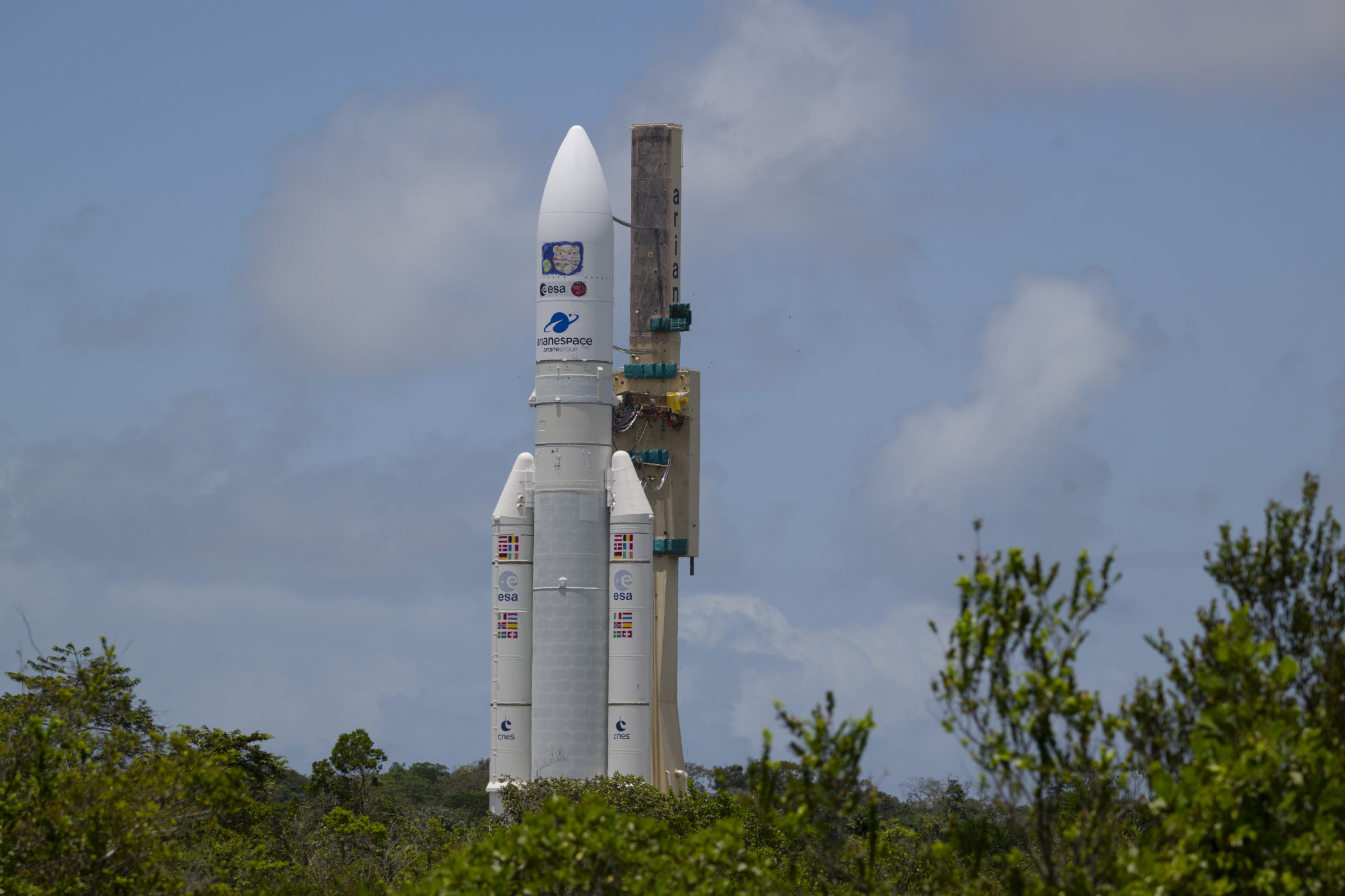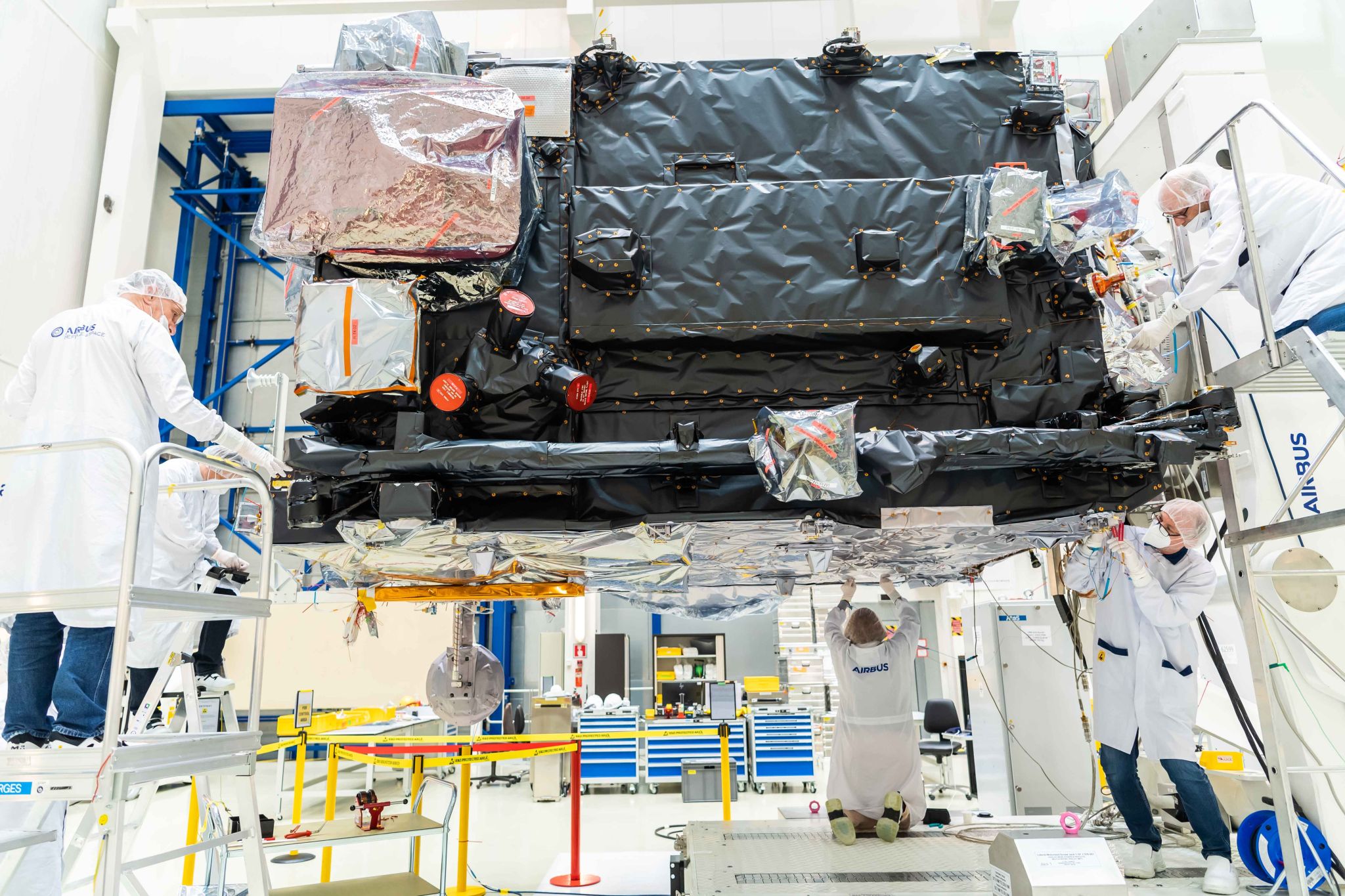JUICE, the ESA mission to Jupiter,
has Portuguese “juice” inside
The interplanetary mission will study the gas giant planet and its icy moons. Several Portuguese companies have contributed to JUICE, which takes off into space this Thursday and will reach its destination within eight years. The Portuguese Bruno Sousa is also one of the flight directors of this mission.
Starting this Friday, April 14, Europe is on its way for the first time to the largest planet in the Solar System. JUICE (acronym for JUpiter ICy Moons Explorer), the European Space Agency’s mission, will explore Jupiter and three of its four largest moons, which may hide oceans and perhaps have (or have had) life. JUICE flew aboard the Ariane 5 rocket from Kourou, the European Spaceport in French Guiana at 13h14 (Lisbon time). Its launch was previously scheduled for April 13, but was canceled due to weather conditions.
This adventure counts with a significant Portuguese participation, both in the industry and in the flight operation. The satellite has components manufactured by the companies LusoSpace, Active Space Technologies, DEIMOS Engenharia, FHP – Frezite High Performance, Efacec and Celestia, as well as an instrument partly designed by the Laboratory of Instrumentation and Experimental Physics (LIP).
This is also another European effort in interplanetary exploration: JUICE will join the ESA missions that have already explored Venus, are exploring Mars and will explore Mercury. Now, Europe is reaching the giant that is 11 times bigger than Earth. The mission is led by ESA, with contributions from NASA and JAXA (Japan Aerospace Exploration Agency).
The journey is long – JUICE is not due to reach its destination until July 2031 – and the expectation is high. Making detailed observations of the gas giant and the moons Callisto, Europa and Ganymede, the mission will also be able to characterise these satellites as planetary objects and possible habitats. Underneath the icy crusts of Europa and Ganymede (and eventually Callisto) there may be oceans of frozen water.
Patrícia Gonçalves, researcher and director of LIP, will attend the launch of the mission from Darmstadt, Germany, as RADEM project leader, an “instrument that was developed with the participation of Portugal (EFACEC and LIP)” in cooperation with the “Norwegian company Ideas and the Swiss research institute Paul Scherrer”. Also an associate professor at the Instituto Superior Técnico she explains that LIP was involved in the development of a “Directionality Detector (DD), one of the subsystems that is part of RADEM”, an instrument that is used to “measure the ionizing radiation environment that the satellite will be subject to during its trajectory, being able to send warning signals so that other JUICE detectors and systems can be protected”.
LIP also supported EFACEC “in all scientific issues related to the design, shielding and design of RADEM, which is in fact a particle detector”. It was also involved “in the analysis of test and calibration data with RADEM particle beams, including the proton, electron, and ion detection sub-systems and not only the directionality detector”, as well as in the verification of the radiation to which the satellite will be subjected, and in the production of the shielding structures that will protect the most sensitive of the various components from radiation. In short, making sure that JUICE works during the entire mission.
A timely moment
Lusospace is joining this ambition. The Lisbon-based aerospace engineering company is no stranger to ESA missions – its MAG28 magnetometer has already been used in three different ESA missions, including Probra-2 —, but this is its “first contribution to an interplanetary mission”.
This time, Lusospace is involved in the study of two of Jupiter’s moons, namely in measuring a large number of physical properties of their magnetic field. The company has developed “a system that allows the calibration” of several scientific magnetometers, called JACS (J-MAG Alignment and Calibration System). These magnetometers are an essential part of the mission since they are “placed at a distance of about ten metres from the JUICE probe” and will “minimise the magnetic disturbance” in the mapping that the satellite will do. Their calibration is therefore crucial. Due to the environment that JACS will be subject to during the mission, the development of this system “had enormous challenges”.

JUICE will fly aboard the Ariane 5 rocket from Kourou, the European Spaceport in French Guiana. © ESA – S. Corvaja
JUICE has “many special things”, said Bruno Sousa a Portuguese aerospace engineer who is also one of the flight directors for this mission, to Exame Informática. “In terms of scientific equipment I would point out a radar to penetrate under the thick layer of ice and explore the oceans of Jupiter’s moons (in particular Ganymede).” As for the construction of the spacecraft, Bruno Sousa highlights the “sophisticated optical navigation system (EAGLE)” that will help to “accurately position the instruments” when the satellite is very close to the moons. “The route around the moons is going to be an extraordinary game of space ping-pong,” he says.
There are two more Portuguese team members in the mission: Marta Pantoquilho, Software Coordinator (assuring that the data systems are working) and Filipe Metelo, as Simulation Officer during the team’s training.
In a very appropriate and “propitious” moment, when “many synergies and complementarities can be created with NASA’s Juno [currently orbiting Jupiter] and Europa Clipper [studying Jupiter’s moon, Europa] missions”, in addition to the aforementioned European interplanetary missions, Active Space has also joined this journey to the giant planet. The Coimbra company came to JUICE as a partner of the Spanish company SENER. This participation consisted of “the co-design, manufacture, assembly and validation and test campaign of the guidance mechanism of the mission’s Medium Gain Antenna (MGA)”, explains a source from Active Space.

FHP provided thermal protection for JUICE. © DR
Oporto-based company, FHP, did what it does best, providing thermal protection for MAG and producing a thermal development model with a “1:1 scale mock-up of the satellite”, which “was used to test the thermal aspect beforehand”. Jupiter’s extreme temperatures, to which JUICE will be subjected, are obviously one of the constraints in the execution of all the elements that make up the mission.
But this is not all: it is also a priority “to ensure that the mission will not hit under any circumstances either the planet Mars or the moon of Jupiter, Europa,” explains DEIMOS‘ official source, who was responsible for developing “software tools” that ensured the success of the mission in this regard. Both Mars and the moon Europa are classified “as Category V according to planetary protection rules”, since they are “solar system bodies which could potentially host life”, together with Enceladus, one of Saturn’s moons. In addition, DEIMOS collaborated in improving the mission’s “basic autonomous navigation strategy during the flyby of Europa and during the orbital phase around Ganymede”.
JUICE already gave us a glimpse of the future
Eight years away from arriving at Jupiter, the JUICE mission has already brought a future for Portugal, allowing the transfer of technology that in the future may be applied in new missions. Lusospace, for instance, says it has acquired “know-how that can be used in similar missions or missions that require the development of large structures that are both resistant to vibrations and thermal variations, but at the same time lightweight”.
For FHP, the participation in the mission allowed the company to gain skills to then “test and qualify the products for other ‘environments’, namely for more extreme temperature conditions and for production techniques that minimize magnetic debris”. On the other hand, Active Space says it has deepened its “experience in developing flight mechanisms for space applications”, which may be used more frequently in “future similar systems”. The company is already doing this for missions such as ATHENA, which is part, like EUCLID or JUICE itself, of the European Space Agency’s Cosmic Vision 2015-2025 programme.
Even though the arrival at Jupiter is still many pages away from being torn up, this European mission has already given rise to a PhD thesis at the Instituto Superior Técnico, and a master’s thesis is also in progress. According to Patrícia Gonçalves, “It has also allowed activities to be developed with other national entities”, such as the Nuclear and Technological Campus of Técnico and the Santa Maria Hospital, “namely in radiation tests of electronic components”.
